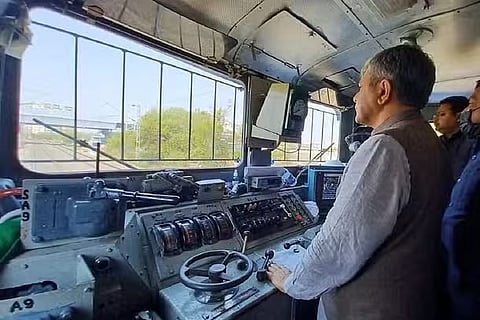India's railways have long been the backbone of its transportation system, ferrying millions of passengers and freight across vast distances daily. As the country modernizes, ensuring the safety of its rail network has become paramount. The Kavach system, an Automatic Train Protection (ATP) technology, is emerging as a pivotal solution to one of the biggest concerns in rail travel—preventing human error and reducing accidents.
Railway Minister Ashwini Vaishnaw will travel today in a Kavach-fitted train in the afternoon for a trial to check the efficiency of the automatic train protection system at Sawai Madhopur in Rajasthan. According to railway officials, Vaishnaw will board the Kavach-fitted engine of a train at 4 pm at the Sawai Madhopur railway station and travel for 45 minutes up to Indargarh Railway station.
"In these 45 minutes, the train will run in (a) Kavach-equipped section at different speeds to see if it stops on its own at red signals without applying brake by the loco pilot," the official said, adding that a team of media persons will also accompany the minister for the trial.
What is the Kavach System?
Developed by the Research Designs and Standards Organisation (RDSO), with three Indian companies — Medha Servo, HBL Power System, and Kernex. The first version, designated Train Collision Avoidance System, underwent field trials in 2015-16 before the specification was formalized in March 2017. Kavach is designed to automatically apply brakes during emergencies when a train driver fails to react in time. This critical feature can potentially save lives and prevent major collisions. The Railway Ministry has been working on implementing this system for the past eight years, planning to roll it out across the country's rail network in phases.
The Kavach System, also known as the Traffic Collision Avoidance System (TCAS), facilitates two-way communication between the station master and the loco-pilot using onboard equipment and transmission towers at stations, enhanced with Radio Frequency Identification (RFID) tags.
How does the Kavach System Work?
The loco-pilot receives advance notifications of signals and the permissible speed limits via the instrument panel in the cabin.
If a red signal is passed or two trains are on the same track, the system automatically activates emergency brakes to prevent collisions.
The hooter also engages automatically when nearing a level crossing, especially useful in foggy conditions with limited visibility.
In emergencies, the system sends out SoS messages, while the Network Monitor System enables centralized, live tracking of train movements.
Advantages of Kavach system
Multi-vendor interoperability: The system ensures flexibility by allowing integration from multiple vendors, preventing monopolies and fostering competition.
Tailored for Indian Railways: Designed to meet the unique requirements and challenging conditions of the Indian railway network.
Enhanced visibility in foggy weather: Kavach proves invaluable in low-visibility situations, ensuring safe train operations even during heavy fog.
Effective at high speeds: The system remains reliable at high-speed operations, ensuring safety without compromising performance.
Centralized real-time monitoring: It enables live tracking of train movements, ensuring better coordination and decision-making.
User-friendly cab signaling: The system provides clear, easy-to-understand signaling for loco-pilots, enhancing their ability to make informed decisions.
